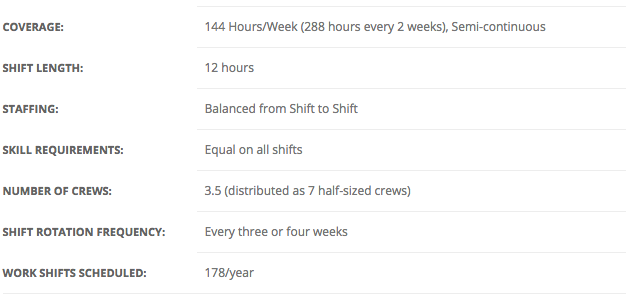Many people consider shift work to be either a 5-day-a-week or a 7-day-a- week proposition. In many cases, this is true. Companies frequently cover 24 hours a day during the week and then cover additional work by using overtime on the weekend. Once overtime becomes too high, companies often try to make the “leap” to a 7-day schedule.
There are several problems with this strategy.
- Overtime can (and frequently does) cost more than straight time. High overtime can lead to high attrition, worker fatigue and recruiting difficulties (especially if your policy is to force overtime on newer employees first.)
- When changing to a 7-day schedule, the sudden loss of overtime can cause worker hardships.
- Overstaffing can occur if a 7-day schedule is “just a little too much” coverage for your needs. Employees will strongly resist a 7-day schedule if they can see that the workload can be handled in something less than 7 days a week.
Six-day schedules can help bridge the gap between 5 and 7-day schedules. They have several advantages over the more traditional 5 and 7-day patterns.
- Improved day-off pattern: A 5-day schedule trying to cover 6 days a week will generate a lot of “unscheduled” work. A 6-day pattern can create a predictable pattern that gives the entire workforce either one day off a week or a full weekend off every other week.
- Overtime control: A 6-day schedule can allow for an infusion of more straight time hours before overtime levels get out of hand.
- Overstaffing: Many companies, fed up with high overtime levels on the weekends, implement 7-day schedules knowing that overtime will immediately go down. They also have reasonable expectations that they will eventually use all of the hours in a week that a 7-day pattern provides. However, until they do, they may find that they cannot fill all of the scheduled hours. This creates idle time which is very expensive.
- Matching the schedule to the workload: Ideally, the shift schedule used by any organization performs its designed function, to put people where the work is. Too much and too little coverage both have adverse morale and cost implications. (see archive schedule #4)
Shift Schedule Parameters

6-Day Shift Schedule

D12 = 12-hour day shift
N12 = 12-hour night shift
This shift schedule is a seven-week cycle staffed by seven equal crews. Each crew is assigned to start their schedule in a different week in the cycle. At the end of each week, all crews move down to the next week in the cycle (or return to Week 1).
Business Issues
- Every day is covered by four half-crews (two half-crews working on each shift). The other three half-crews are on their days off. This allows your operations to be covered continuously with full crews.
- There are two shift handoffs each day. This normally improves communication during the two days that the same crews are working –information is received from, and passed on to, the same person each day. Unfortunately, the frequent days off minimizes this benefit.
- Absence management systems may need to be in place to ensure coverage is available. If personnel are not available on-shift to cover for illness and other unscheduled absences, personnel on their day off are needed to provide the proper coverage.
- The actual hours worked in each week varies between 36 and 48 hours. The average workweek is 41.14 hours.
Employee Issues
- Weekend work is much harder on employees due to the adverse impact on family and social issues. Five out of every 8 shift workers would prefer Saturday work over Sunday work. 178 workdays each year, with 186 days off. Employees work 57% of their Saturdays. They get 22 full weekends off a year along with 100% of their Sundays.
This schedule demonstrates how additional straight time hours can be added to an operation thereby reducing overtime without overstaffing.
Call Us and We Can Help
Call or text us today at (415) 763-5005 to discuss your operations and how we can help you solve your shift work problems. You can also complete our contact form and we will call you.
